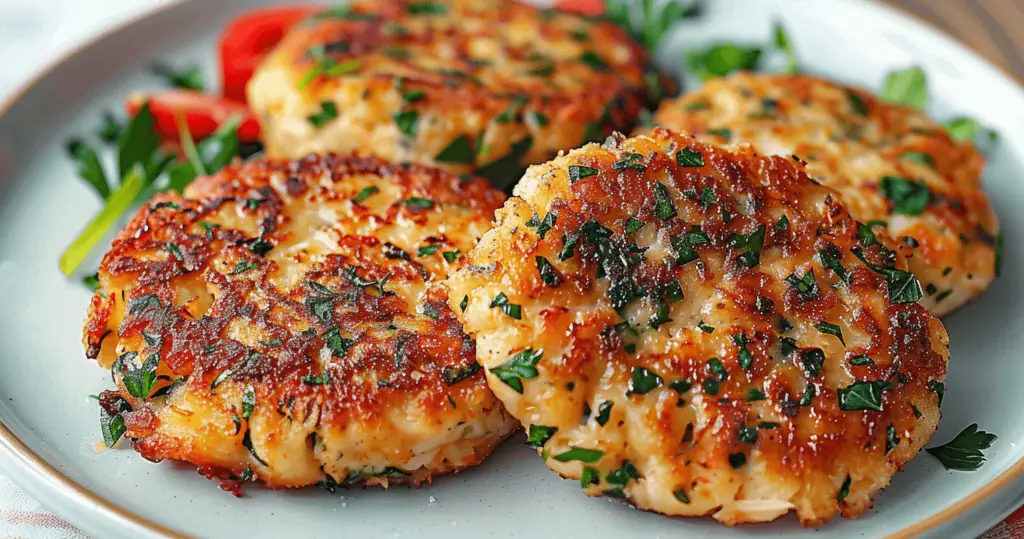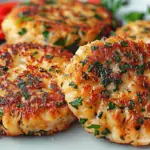Salmon Cakes are a delicious and nutritious dish that combines the rich flavor of salmon with a crispy exterior and a tender, flaky interior. Perfect for family dinners, parties, or meal prep, these cakes are versatile and easy to make. In this comprehensive guide, you’ll learn how to prepare and cook mouthwatering Salmon Cakes from scratch, including essential tips for preparation, cooking, and serving. Whether you’re a seafood lover or new to cooking fish, this guide will help you create a meal that everyone will love.

Overview of Salmon Cakes
Salmon Cakes are patties made from flaked salmon mixed with breadcrumbs, herbs, and spices, then formed into cakes and cooked until crispy. These cakes are similar to crab cakes but use salmon as the primary ingredient. The key ingredients include cooked salmon, breadcrumbs, eggs, and various seasonings to enhance the flavor. Compared to other seafood cakes, Salmon Cakes are packed with omega-3 fatty acids and essential nutrients, making them a healthy and satisfying option.
Brief History and Cultural Significance
Salmon Cakes have a rich history, particularly in regions where salmon is abundant. Originally a way to use leftover salmon, these cakes have evolved into a popular dish enjoyed worldwide. In the United States, salmon cakes are a staple in many households, especially in coastal areas. They are often served at family gatherings, picnics, and special occasions. The cultural significance of salmon cakes lies in their simplicity, versatility, and ability to bring people together over a delicious meal.
Preparation Phase & Tools to Use
Making Salmon Cakes at home requires a few essential tools and some preparation. Here’s an overview of the time and equipment needed:
- Prep Time: 15 minutes
- Cook Time: 15-20 minutes
- Total Time: 30-35 minutes
- Servings: 4-6 servings
- Yield: 8-10 salmon cakes
Essential Tools and Equipment
To create the perfect Salmon Cakes, you will need the following tools:
- Mixing Bowls: For combining ingredients.
- Measuring Cups and Spoons: For accurate measurement of ingredients.
- Baking Sheet or Skillet: For cooking the salmon cakes.
- Spatula: For flipping the cakes.
- Food Processor (optional): For finely chopping ingredients.
- Oven or Stovetop: For cooking the salmon cakes.
Importance of Each Tool
Using the right tools ensures the best results. Mixing bowls and measuring tools help achieve the correct proportions for the mixture. A baking sheet or skillet provides a flat surface for cooking the cakes evenly. A spatula is essential for flipping the cakes without breaking them. A food processor can be used for finely chopping ingredients, although this can also be done by hand. Cooking the salmon cakes in an oven or on a stovetop allows for different methods of achieving a crispy exterior and tender interior.
Preparation Tips
- Use Fresh Ingredients: Fresh and high-quality ingredients enhance the flavor and texture of the salmon cakes. Opt for fresh salmon, herbs, and spices for the best results.
- Properly Measure Ingredients: Accurate measurements ensure the mixture has the right consistency.
- Flake the Salmon Thoroughly: Ensure the salmon is flaked into small, uniform pieces for even distribution throughout the cakes.
- Preheat the Oven or Skillet: Ensure the cooking surface is preheated to the correct temperature before adding the salmon cakes to achieve even cooking.
Ingredients List
Here is the complete list of ingredients needed to make Salmon Cakes:
- For the Salmon Cakes:
- 1 lb cooked salmon, flaked
- 1 cup breadcrumbs
- 1/4 cup finely chopped onion
- 1/4 cup finely chopped celery
- 2 tablespoons mayonnaise
- 1 tablespoon Dijon mustard
- 1 large egg, beaten
- 1 tablespoon lemon juice
- 1 tablespoon fresh dill, chopped
- 1/2 teaspoon salt
- 1/4 teaspoon black pepper
- For the Coating:
- 1/2 cup breadcrumbs
- 1/4 cup grated Parmesan cheese
- For Cooking:
- 2 tablespoons olive oil or vegetable oil
Step-by-Step Instructions
1. Prepare the Salmon Mixture
- Flake the Salmon: Use a fork to flake the cooked salmon into small pieces.
- Combine Ingredients: In a large mixing bowl, combine the flaked salmon, breadcrumbs, chopped onion, chopped celery, mayonnaise, Dijon mustard, beaten egg, lemon juice, fresh dill, salt, and pepper.
- Mix Thoroughly: Use a spatula or your hands to mix everything until well combined. The mixture should be moist but firm enough to hold its shape.
2. Form the Salmon Cakes
- Shape the Cakes: Divide the mixture into equal portions and shape each portion into a patty about 1 inch thick.
- Coat the Cakes: In a shallow bowl, mix the additional breadcrumbs and grated Parmesan cheese. Dredge each salmon cake in the breadcrumb mixture, coating both sides evenly.
3. Cook the Salmon Cakes
- Heat the Oil: In a large skillet, heat the olive oil over medium-high heat.
- Cook the Cakes: Place the salmon cakes in the skillet and cook for 3-4 minutes on each side, or until golden brown and crispy. Alternatively, you can bake the salmon cakes in a preheated oven at 400°F (200°C) for 15-20 minutes, turning once halfway through.
4. Finish and Serve
- Drain Excess Oil: If frying, transfer the cooked salmon cakes to a paper towel-lined plate to drain any excess oil.
- Serve: Serve the salmon cakes hot with your favorite dipping sauce or alongside a fresh salad.
Side Dish Recommendations
Pairing Salmon Cakes with complementary side dishes can elevate your meal. Here are some perfect pairings that enhance the flavors and textures of your Salmon Cakes:
Perfect Pairings
Coleslaw
- Description: A classic side dish for seafood, coleslaw provides a cool, crunchy, and tangy contrast to the rich and crispy salmon cakes. The crisp texture and zesty flavor balance the meal.
- Recipe Idea: Shred cabbage and carrots, then toss with a dressing made from mayonnaise, apple cider vinegar, sugar, salt, and pepper.
Roasted Vegetables
- Description: Roasted vegetables add a hearty and flavorful component to your meal. The caramelized edges and tender interior of the vegetables complement the salmon cakes.
- Recipe Idea: Roast a mix of broccoli, bell peppers, zucchini, and carrots with olive oil, salt, pepper, and your favorite herbs.
Mixed Green Salad
- Description: A fresh mixed green salad with a light vinaigrette provides a refreshing and healthy side to the salmon cakes. The crisp greens and tangy dressing balance the richness of the salmon cakes.
- Recipe Idea: Toss mixed greens with cherry tomatoes, cucumbers, red onions, and a simple vinaigrette made from olive oil, vinegar, Dijon mustard, and honey.
Garlic Mashed Potatoes
- Description: Creamy garlic mashed potatoes add a comforting and hearty side to your salmon cakes. The smooth texture and rich flavor complement the crispy cakes.
- Recipe Idea: Boil potatoes with garlic cloves until tender, then mash with butter, cream, salt, and pepper.
Quinoa Salad
- Description: A light and nutritious quinoa salad pairs well with salmon cakes. The nutty flavor of quinoa and the fresh ingredients in the salad add a healthy and tasty element.
- Recipe Idea: Cook quinoa and mix with diced cucumbers, cherry tomatoes, red onions, parsley, and a lemon vinaigrette.
Tartar Sauce
- Description: Classic tartar sauce adds a tangy and creamy element to the salmon cakes. The sauce enhances the flavors of the fish and adds a delicious contrast.
- Recipe Idea: Combine mayonnaise, chopped pickles, capers, lemon juice, and fresh dill for a homemade tartar sauce.
Nutritional Information & Health Benefits
Understanding the nutritional profile and health benefits of Salmon Cakes can help you appreciate their value as part of a balanced diet.
Nutritional Profile
Salmon Cakes provide a mix of macronutrients and essential vitamins and minerals. Here’s a general breakdown of their nutritional content per serving (1 cake):
- Calories: Approximately 150-200 calories
- Proteins: 14-18 grams
- Carbohydrates: 10-15 grams
- Fats: 8-10 grams
- Vitamins and Minerals: Contains significant amounts of omega-3 fatty acids, vitamin D, vitamin B12, and selenium
Health Benefits
High Protein Content
Salmon Cakes are an excellent source of protein, which is essential for muscle repair and growth. Protein also helps keep you full and satisfied, making it a great option for a hearty meal.
Rich in Omega-3 Fatty Acids
Salmon is one of the best sources of omega-3 fatty acids, which are beneficial for heart health, brain function, and reducing inflammation.
Essential Vitamins and Minerals
Salmon Cakes are rich in essential vitamins and minerals such as vitamin D, vitamin B12, and selenium, which support overall health, including immune function, energy production, and bone health.
Low in Carbohydrates
Salmon Cakes are naturally low in carbohydrates, making them a suitable option for low-carb and keto diets.
Common Mistakes to Avoid & How to Perfect the Recipe
Ensuring the perfect Salmon Cakes requires avoiding common pitfalls and implementing expert tips for success.
Common Mistakes
Not Draining the Salmon
Failing to drain canned salmon properly can result in a wet mixture that doesn’t hold together well. Make sure to drain the salmon thoroughly before flaking it.
Overmixing the Mixture
Overmixing can lead to dense and tough salmon cakes. Mix just until the ingredients are combined and the mixture holds together.
Not Using Enough Binder
If the mixture doesn’t have enough binder (egg and breadcrumbs), the salmon cakes can fall apart during cooking. Ensure you have the right balance of ingredients to bind the mixture together.
Cooking at Too High a Temperature
Cooking the salmon cakes at too high a temperature can cause the exterior to burn while the interior remains undercooked. Cook at medium heat to ensure even cooking.
Tips for Perfection
Achieving the Perfect Texture
Ensure the salmon is flaked into small, uniform pieces for even distribution. The mixture should be moist but firm enough to hold its shape when formed into cakes.
Balancing Flavors
Adjust the seasoning to your taste preferences. You can add different herbs and spices to the mixture to create unique flavor profiles. For a spicier kick, add a pinch of cayenne pepper.
Crispy Exterior
For a crispy exterior, coat the salmon cakes in a mixture of breadcrumbs and Parmesan cheese before cooking. This adds a delicious crunch to each bite.
Resting the Cakes
Allow the formed salmon cakes to rest in the refrigerator for about 30 minutes before cooking. This helps them firm up and hold their shape during cooking.
By following these tips and avoiding common mistakes, you can perfect your Salmon Cakes and enjoy a delicious, satisfying meal that is sure to become a favorite.
Tips, Notes, Storing, and Reheating
Tips and Notes
- Use Fresh Ingredients: Fresh and high-quality ingredients enhance the flavor and texture of the salmon cakes. Opt for fresh salmon, herbs, and spices for the best results.
- Ensure Proper Binding: The mixture should be moist but firm enough to hold its shape. If it’s too wet, add more breadcrumbs; if too dry, add a bit more mayonnaise or a beaten egg.
- Chill the Mixture: Chilling the salmon cakes in the refrigerator for at least 30 minutes before cooking helps them hold their shape and prevents them from falling apart during cooking.
- Adjust Seasoning: Taste the mixture before forming the cakes and adjust the seasoning as needed. Adding a bit of lemon zest can enhance the flavor of the salmon.
- Use a Non-Stick Pan: When frying the salmon cakes, use a non-stick pan to prevent them from sticking and ensure a nice, even crust.
Storing
- Refrigeration: Store leftover salmon cakes in an airtight container in the refrigerator for up to 3 days. Ensure they are completely cooled before storing to maintain their texture.
- Freezing: Freeze the uncooked salmon cakes in a single layer on a baking sheet. Once frozen, transfer them to a freezer-safe container or bag. They can be stored for up to 3 months. Thaw in the refrigerator before cooking.
Reheating
- Oven: Preheat your oven to 350°F (175°C). Place the salmon cakes on a baking sheet and cover with aluminum foil to prevent drying out. Heat for 10-15 minutes or until warmed through.
- Stovetop: Reheat the salmon cakes in a non-stick skillet over medium heat for 3-5 minutes on each side or until heated through.
- Microwave: Place the salmon cakes on a microwave-safe plate and cover. Microwave on medium power for 1-2 minutes, turning halfway through, until heated through. Note that microwaving may soften the crispy exterior.
FAQs
Can I use canned salmon for this recipe?
- Yes, you can use canned salmon. Ensure it is well-drained and flaked. Fresh salmon is preferable for the best flavor and texture, but canned salmon is a convenient and tasty alternative.
What can I substitute for breadcrumbs to make the recipe gluten-free?
- You can use gluten-free breadcrumbs or crushed gluten-free crackers. Another option is using almond flour or finely ground oats.
Can I make the salmon cakes in advance?
- Yes, you can prepare the salmon mixture and form the cakes in advance. Store them in the refrigerator for up to 24 hours before cooking. This makes meal prep easier and allows the flavors to meld.
How can I make the salmon cakes spicier?
- To add more heat, increase the amount of black pepper or add a pinch of cayenne pepper or red pepper flakes to the mixture. You can also serve the salmon cakes with a spicy dipping sauce.
Can I bake the salmon cakes instead of frying them?
- Yes, baking is a healthier alternative. Preheat your oven to 400°F (200°C) and bake the salmon cakes on a greased baking sheet for 15-20 minutes, flipping halfway through, until they are golden brown and crispy.
Conclusion
Salmon Cakes are a delightful and versatile dish that combines the rich flavors of salmon with a crispy, golden exterior. By following the detailed instructions and tips provided in this guide, you can create a delicious and nutritious meal that is perfect for any occasion. Experiment with different flavors, seasonings, and side dishes to make the recipe your own, and enjoy the process of making and sharing these tasty salmon cakes with family and friends.
Print
Salmon cakes recipe
Description
Learn how to make delicious Salmon Cakes with our ultimate guide. Perfect for family dinners and special occasions!
Ingredients
Ingredients List
Here is the complete list of ingredients needed to make Salmon Cakes:
- For the Salmon Cakes:
- 1 lb cooked salmon, flaked
- 1 cup breadcrumbs
- 1/4 cup finely chopped onion
- 1/4 cup finely chopped celery
- 2 tablespoons mayonnaise
- 1 tablespoon Dijon mustard
- 1 large egg, beaten
- 1 tablespoon lemon juice
- 1 tablespoon fresh dill, chopped
- 1/2 teaspoon salt
- 1/4 teaspoon black pepper
- For the Coating:
- 1/2 cup breadcrumbs
- 1/4 cup grated Parmesan cheese
- For Cooking:
- 2 tablespoons olive oil or vegetable oil
Instructions
Step-by-Step Instructions
1. Prepare the Salmon Mixture
- Flake the Salmon: Use a fork to flake the cooked salmon into small pieces.
- Combine Ingredients: In a large mixing bowl, combine the flaked salmon, breadcrumbs, chopped onion, chopped celery, mayonnaise, Dijon mustard, beaten egg, lemon juice, fresh dill, salt, and pepper.
- Mix Thoroughly: Use a spatula or your hands to mix everything until well combined. The mixture should be moist but firm enough to hold its shape.
2. Form the Salmon Cakes
- Shape the Cakes: Divide the mixture into equal portions and shape each portion into a patty about 1 inch thick.
- Coat the Cakes: In a shallow bowl, mix the additional breadcrumbs and grated Parmesan cheese. Dredge each salmon cake in the breadcrumb mixture, coating both sides evenly.
3. Cook the Salmon Cakes
- Heat the Oil: In a large skillet, heat the olive oil over medium-high heat.
- Cook the Cakes: Place the salmon cakes in the skillet and cook for 3-4 minutes on each side, or until golden brown and crispy. Alternatively, you can bake the salmon cakes in a preheated oven at 400°F (200°C) for 15-20 minutes, turning once halfway through.
4. Finish and Serve
- Drain Excess Oil: If frying, transfer the cooked salmon cakes to a paper towel-lined plate to drain any excess oil.
- Serve: Serve the salmon cakes hot with your favorite dipping sauce or alongside a fresh salad.
Notes
- Use Fresh Ingredients: Fresh and high-quality ingredients enhance the flavor and texture of the salmon cakes. Opt for fresh salmon, herbs, and spices for the best results.
- Ensure Proper Binding: The mixture should be moist but firm enough to hold its shape. If it’s too wet, add more breadcrumbs; if too dry, add a bit more mayonnaise or a beaten egg.
- Chill the Mixture: Chilling the salmon cakes in the refrigerator for at least 30 minutes before cooking helps them hold their shape and prevents them from falling apart during cooking.
- Adjust Seasoning: Taste the mixture before forming the cakes and adjust the seasoning as needed. Adding a bit of lemon zest can enhance the flavor of the salmon.
- Use a Non-Stick Pan: When frying the salmon cakes, use a non-stick pan to prevent them from sticking and ensure a nice, even crust.


Leave a Comment